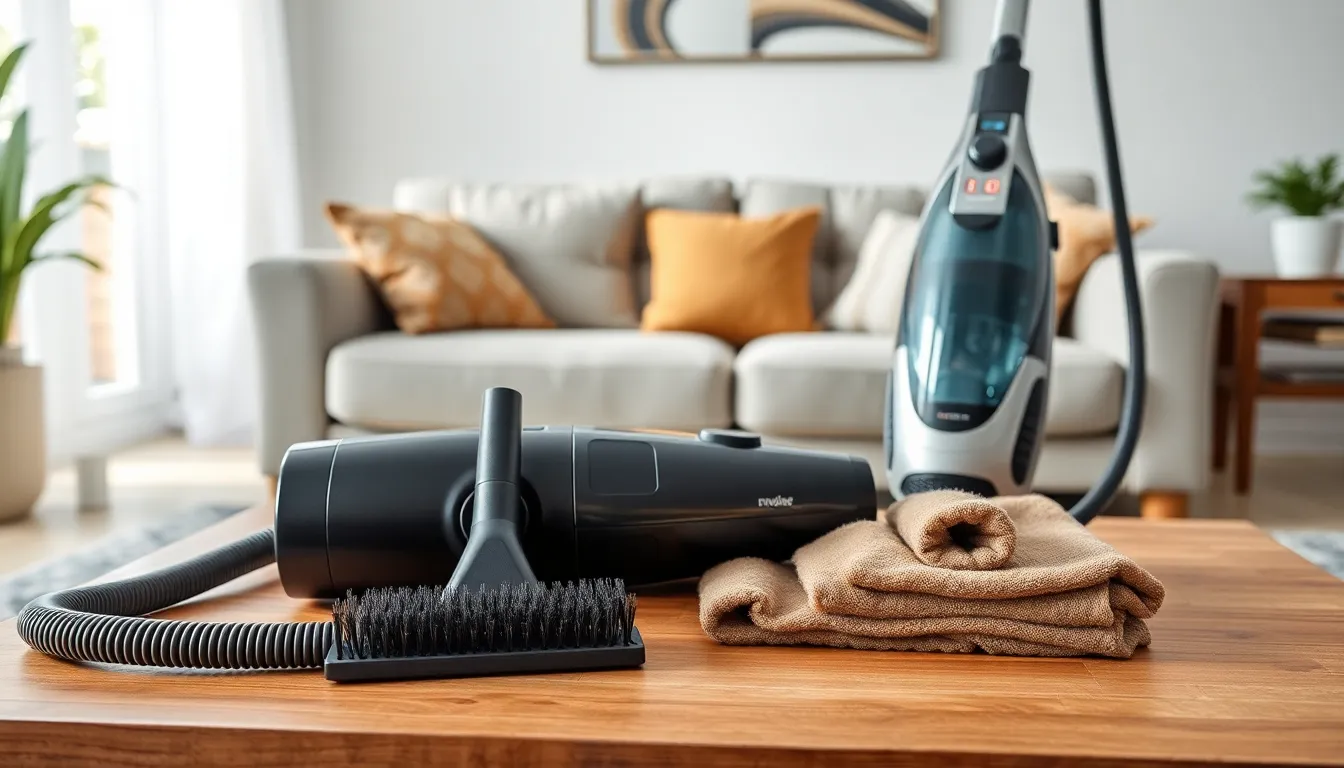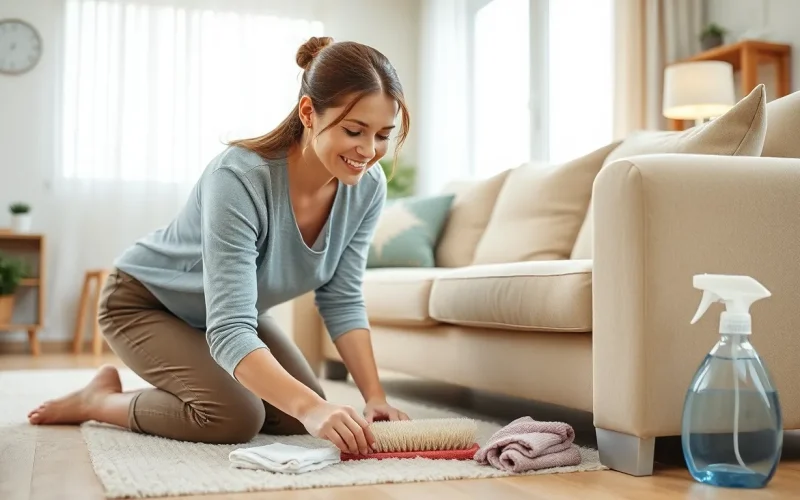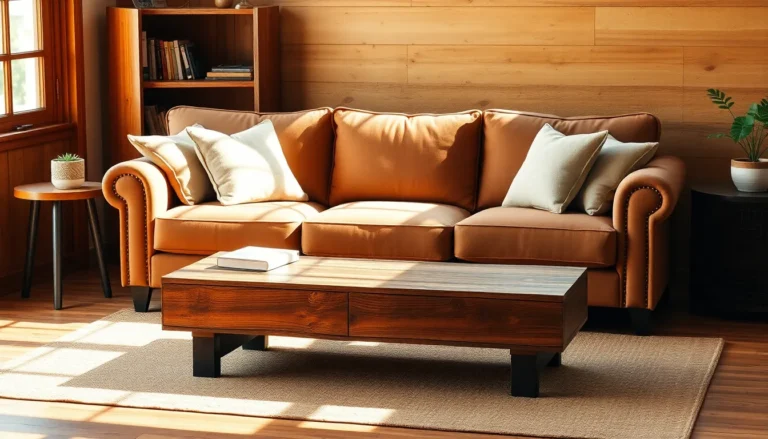Table of Contents
ToggleCleaning furniture fabric might sound like a chore, but it doesn’t have to be a battle of wills with that stubborn stain. With the right tricks up your sleeve, you can transform your beloved couch from a crime scene of snack attacks to a pristine throne fit for royalty. Who knew that keeping your furniture fresh could be as satisfying as finding an extra fry at the bottom of the bag?
Understanding Furniture Fabric
Understanding furniture fabric involves recognizing its various types and the common challenges associated with each. Different materials require specific care techniques.
Types of Furniture Fabric
Synthetic fabrics, like polyester and nylon, are durable and often stain-resistant. Natural fabrics, such as cotton, linen, and wool, provide a softer feel but can be more susceptible to staining. Microfiber is popular due to its easy maintenance and resistance to spills. Leather offers elegance and longevity but requires regular conditioning to keep from drying out. Blends combine different fibers, offering unique benefits like enhanced durability and easier cleaning.
Common Stains and Issues
Food and drink spills, like coffee or wine, create noticeable stains on furniture fabric. Pet accidents can lead to odor and discoloration problems. Additionally, dirt and dust accumulation dulls fabric appearance over time. Ink marks from pens or markers might seem permanent but can often be treated with appropriate cleaners. Grease and oil stains from food preparation are particularly tricky but manageable with the right approach. Recognizing these issues aids in selecting suitable cleaning methods to preserve furniture fabric.
Preparation for Cleaning

Preparation plays a crucial role in cleaning furniture fabric effectively. Gather the right supplies and evaluate colorfastness to ensure a successful cleaning process.
Gathering Necessary Supplies
Identify essential cleaning supplies before starting the cleaning process. Gather a vacuum cleaner equipped with upholstery attachments, soft brushes, and microfiber cloths. Include a gentle fabric cleaner designed for the specific type of fabric. Collect plain water and a spray bottle for dilution. Keep white towels handy for absorbing excess moisture and cleaning agents. Ensure all items are ready within arm’s reach for a seamless cleaning experience.
Testing for Colorfastness
Test colorfastness to prevent damage during cleaning. Choose an inconspicuous area and apply a small amount of the cleaning solution. Use a cotton swab or soft cloth for this purpose. Observe for any discoloration or bleeding after a few minutes. If the fabric shows no negative effects, proceed with confidence. In case of color loss or fading, consider consulting a professional cleaner or opting for a gentler cleaning method instead.
Cleaning Methods
Cleaning furniture fabric involves several effective methods. These methods address various stains and dirt types, helping preserve the fabric’s integrity.
Spot Cleaning Techniques
Spot cleaning effectively targets specific stains on furniture fabric. Start by applying a small amount of a gentle cleaner directly to the stain. Blot gently with a clean, white cloth, working from the outside towards the center. This technique minimizes the risk of spreading the stain. For tougher stains, consider using a soft-bristled brush to lift the dirt. Test any cleaning solution on a hidden area first to ensure it doesn’t damage the fabric. Act promptly for the best results, as fresh stains are easier to clean than older, set-in ones.
Upholstery Cleaning with Steam
Upholstery cleaning with steam offers a deep, thorough clean. Begin by preparing a steam cleaner specifically designed for upholstery. Apply steam to the fabric while maintaining a safe distance to avoid moisture damage. The heat breaks down dirt and stains effectively. Use a microfiber cloth to absorb any excess moisture during the process. Allow the fabric to dry completely afterward, using a fan or air circulation to speed up drying time. Regular steam cleaning aids in maintaining the furniture’s appearance and prolongs its lifespan.
Using a Vacuum Cleaner
Using a vacuum cleaner is crucial for regular maintenance of furniture fabric. Select an upholstery attachment to remove dust and debris from the surface. Focus on seams and crevices where dirt collects. Frequent vacuuming prevents dirt buildup and keeps fabrics looking fresh. If the furniture has removable cushions, vacuum both sides for thorough cleaning. Adjust the vacuum’s suction settings if necessary to protect delicate fabrics. A well-maintained vacuum cleaner enhances its effectiveness and prolongs the life of the furniture.
DIY Cleaning Solutions
A variety of DIY cleaning solutions exist for maintaining furniture fabric. These options range from natural ingredients to commercial products, allowing for flexibility based on preferences and needs.
Natural Cleaning Solutions
Natural cleaning solutions effectively address common fabric stains using household ingredients. Vinegar acts as a gentle disinfectant, combining one part vinegar with two parts water for a safe cleaning mix. Baking soda serves as an excellent deodorizer, simply sprinkling it on the affected area and letting it sit for 15 minutes enhances freshness. For an all-purpose cleaner, mixing dish soap with warm water creates a mild solution. Essential oils like tea tree oil can also be added for scent and added antibacterial properties. These natural solutions are non-toxic and environmentally friendly, making them ideal for households with pets or children.
Commercial Cleaning Products
Commercial cleaning products offer specific formulations for different fabric types, ensuring effective stain removal. Upholstery cleaners generally contain enzymes that target organic stains like food or pet messes. Many of these cleaners come in spray bottles for easy application, simplifying the cleaning process. It’s essential to follow manufacturer instructions to avoid potential damage. Look for products labeled as safe for the particular fabric type when selecting a cleaner. Various brands offer upholstery wipes for on-the-go cleaning, providing convenience and portability. Using these products can enhance the cleaning experience, contributing to furniture longevity.
Maintaining Clean Furniture Fabric
Maintaining clean furniture fabric ensures lasting beauty and comfort. Regular attention prevents dirt buildup and keeps upholstery looking fresh.
Regular Maintenance Tips
Vacuum upholstery weekly to remove dust and debris. Use an upholstery attachment to reach seams and crevices effectively. Avoid using harsh chemicals; instead, clean with mild solutions. Spot clean spills immediately to prevent stains from setting. Blot affected areas gently with a clean cloth instead of rubbing. Rotate cushions regularly to promote even wear and prolong lifespan. Take care with pets, keeping them groomed and off furniture when possible. Schedule professional cleanings every 12 to 24 months for thorough upkeep.
Protecting Your Furniture Fabric
Consider applying a fabric protector to shield against spills and stains. Fabrics like polyester often resist stains more effectively; choose them for high-use areas. Avoid placing furniture in direct sunlight; UV rays can fade colors over time. Use coasters and trays in dining areas to minimize chances of ring stains. Implement a no-food or no-drink policy on certain items to prevent accidental spills. Additionally, rearranging furniture can help minimize wear in high-traffic spots. Investing in slipcovers provides a layer of protection and allows for easy washing.
Maintaining clean furniture fabric is achievable with the right approach and tools. By understanding the specific needs of different fabric types and employing effective cleaning techniques, anyone can keep their furniture looking fresh and inviting. Regular maintenance practices like vacuuming and immediate spot cleaning can significantly extend the life of upholstery.
Incorporating protective measures such as fabric protectors and mindful usage can prevent future stains. With a little effort and the right knowledge, it’s possible to enjoy beautiful, clean furniture that enhances any living space.





